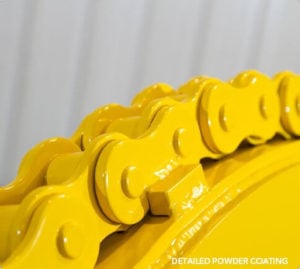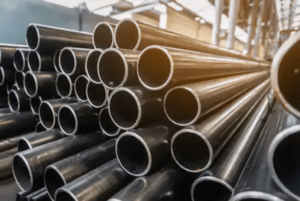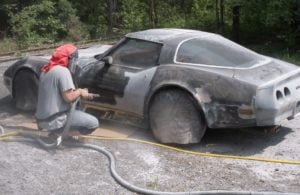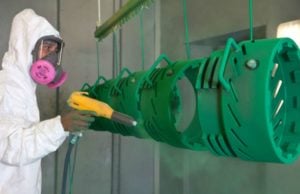Sandblasting, also called abrasive blasting, involves using air pressure to force small, abrasive particles at a surface at high speed to clean it or change its texture. The process used to involve using sand, but now there are different (and better) materials for the task.
Related: Is Abrasive Blasting the Right Metal Finishing Solution for You?
What is Sand Blasting Used For?
Sandblasting is used in many professions like construction and autobody work. The purpose of sandblasting depends on the type of project. It can be used to strip the existing paint and rust from the body of a vehicle before painting or take the paint off the siding of a house. It can be used to remove scale from steel. It is also used for cleaning sidewalks and roads. Some people even use sandblasting to create art by etching glass. Regardless, sandblasting is one of the earliest preparation elements in any painting or coating process.
Preparation is arguably the most important part of a project. It is the foundation, and without that solid start, the rest of the project is more likely to have issues. Proper sandblasting can avoid this by creating the right texture that ensures paint and other media will adhere to the surface.
Why is Sand Blasting Important?
Sandblasting helps make sure the surface of a project is clean, too, so no particles create an uneven surface or problems with adherence. It clears away paint, rust, dust, and dirt before the rest of the process even starts. Skipping this step means the new coating can peel more easily, which means the project will need to be redone.
What Are the Benefits of Sand Blasting?
One of the main reasons to sandblast as opposed to hand sanding is its efficiency. With sanding by hand or using brushes, cleaning and surface preparation could take three times as long. Sandblasting is more thorough, too. While sanding by hand does smooth a surface, the quality of the end result depends largely on the person’s strength and eye for detail.
To some degree, this is true for sandblasting as well. Details are important, regardless. However, sandblasting can cover a wider area much more evenly than sandpaper. Along with its overall speed, this allows more work to be done without sacrificing quality. In fact, sandblasting is much more likely to raise the quality above that of other surface preparation methods.
Abrasive materials are fairly cheap and sometimes reusable, which makes them doubly cost-effective. Certain materials are more expensive than others, but even so, that cost can be made up when sandblasting cuts down on labor and time.
The media used for sandblasting varies depending on the project because, despite its name, it is rarely sand. Sand becomes a fine powder once it has been used in sandblasting, which makes it impossible to reuse. It can also cause respiratory problems due to the silica in it, and it contains more moisture and particles that can damage equipment. For this reason, the use of sand in sandblasting is virtually obsolete.
Though there is safety equipment one should use no matter the media, there are now more effective materials than sand. Each one has a distinct use—some are better for wood whereas others are good for glass, and others for steel. Some of these include:
Glass Beads
Glass beads come in many sizes. They work best for removing paint and rust from metal surfaces. They are also great for cleaning and are ideal for preparation when it comes to painting and powder coating.
Coal Slag
Coal slag is sometimes referred to as black beauty. It is often used in the auto industry because of its coarse texture and its effectiveness at removing rust and paint. Coal slag is one of the most inexpensive types of media. Unlike sand, it does not hold moisture and is easy to clean up.
Aluminum Oxide
Aluminum oxide has some of the fastest cutting time of any material used in sandblasting. It is reusable and produces minimal dust. It is used most often to remove paint and clean surfaces. Because it can be used more than once, it reduces costs.
Walnut Shells
Walnut shells are softer than some other options, and while they can be used for stripping paint, cleaning surfaces is a better application for them. They are often used in cleaning more sensitive surfaces like wood.
Corn Cob
Ground corn cobs have a similar use to walnut shells, and as another softer medium, can be used in much the same way. The best use for corn cobs is cleaning surfaces like stone and glass. They are also often used in wood crafts.
Plastic Grit
Plastic grit is one of the most versatile types of sandblasting material. It comes in many shapes and sizes, which means it can be used on a variety of projects. Plastic grit is great for use on fiberglass, and as a harder material, is ideal for vehicle, boat, and aircraft parts.
Steel Shot and Grit
Due to its own durability, steel shot and grit is best for use on steel parts. There are many varieties to choose from, and it can be used to prepare steel surfaces by removing rust and paint, as well as leaving a smooth area for coatings like epoxy.
Silicone Carbide
Silicone carbide is the hardest material currently available for sandblasting. It comes in several different sizes, and therefore can be used on a variety of projects, especially if the project requires a tougher abrasive. Silicone carbide is especially useful for polishing granite and other types of hard stone.
Staurolite
Staurolite is made from metamorphic rock and is a weaker type of abrasive. For this reason, it is best used to clear away thin coats of rust, scale, and paint, though it may not work well on thicker layers. This is another option that produces very little dust.
Sandblasting is the overall most efficient way of cleaning surfaces and preparing them for a new coat of paint, epoxy, or powder coating. As the most essential step to any project process, it creates the proper texture and removes any surface grit and grime for a beautiful end product. With a wide variety of materials to use for sandblasting, it can be done on metal, plastic, wood, and more. It comes down to using the proper equipment, materials, and safety precautions to ensure a successful finish.
Related: Everything Engineers and Product Manufacturers Need to Know About Industrial Metal Finishing






